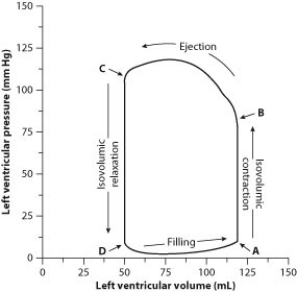To evaluate cardiac function, scientists and physicians measure both the pressure and the volume inside the heart. When both pressure and volume data are plotted on the same graph, the resulting graph is called a pressure-volume loop. To create a pressure-volume loop, a catheter (a thin tube) is inserted into the vessels of the heart, and measurements of both left ventricular pressure and left ventricular volume are taken. The data are plotted on a graph, and cardiac function can then be evaluated from the distribution of the data and the shape of the loop.
The following figure shows a typical left ventricle pressure-volume loop for a healthy young adult. The cardiac cycle proceeds counterclockwise. Each complete turn around the loop (for example, starting at point A and ending back at point A) represents one complete cardiac cycle.

-What part of the diagram represents ventricular diastole?
A) point B
B) point C
C) the line between points A and B
D) the line between points C and D
Correct Answer:
Verified
Q60: To view the path of blood flow
Q61: Excessive accumulation of fluid in tissues outside
Q62: A red blood cell is in an
Q63: Which part of this figure depicts an
Q64: In which part of this figure would
Q66: Which part of this figure depicts a
Q67: To evaluate cardiac function, scientists and physicians
Q68: You are taking someone's blood pressure and
Q69: Electrocardiographs (ECGs or EKGs) provide data about
Q70: To evaluate cardiac function, scientists and physicians
Unlock this Answer For Free Now!
View this answer and more for free by performing one of the following actions

Scan the QR code to install the App and get 2 free unlocks

Unlock quizzes for free by uploading documents